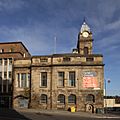Sheffield Old Town Hall facts for kids
Quick facts for kids Sheffield Old Town Hall |
|
|---|---|

Sheffield Old Town Hall seen from the east from Waingate. Castle Street is on the left.
|
|
| Location | Sheffield |
| Built | 1808 |
| Architect | Charles Watson |
| Architectural style(s) | Neoclassical style |
|
Listed Building – Grade II
|
|
| Designated | 28 June 1973 |
| Reference no. | 1247500 |
| Lua error in Module:Location_map at line 420: attempt to index field 'wikibase' (a nil value). | |
The Sheffield Old Town Hall is an important old building in the city of Sheffield, South Yorkshire, England. It's located in an area called Waingate, right across from Castle Market. This building is so special that it's officially protected as a Grade II listed building. This means it's a historic place that needs to be kept safe for the future.
Contents
A Look at the Old Town Hall's History
The story of Sheffield's town hall buildings goes back a long way. Records from 1637 mention a very early "Sheffield Towne Hall." This first building was later replaced by a second one.
=The Second Town Hall (1700)
The second town hall was designed by William Renny. It opened in the year 1700. This building was right next to the main parish church. However, it didn't have much room to grow or be made bigger.
Building the Old Town Hall (1808)
The building we now call the "Old Town Hall" is actually the third one. It was designed by an architect named Charles Watson. He built it between 1807 and 1808. The building was made in a style called Neoclassical. This style often uses ideas from ancient Greek and Roman buildings.
When it was first built, the Old Town Hall had five sections. It faced Castle Street. It was made to be a place for important local groups. These included the Town Trustees. It also housed courts for local legal matters. These were called the Petty and Quarter Sessions.
Making the Building Bigger
The Old Town Hall was made larger several times. It was extended in 1833. Then, it was made bigger again in 1866. These changes were designed by William Flockton and his partner George Abbott.
A big new feature was added in 1866: a central clock tower. This tower was built over a new main entrance. This changed the building's main direction to face Waingate. The materials for the tower came from parts of the old building that were taken down. At this time, the building's courtrooms were also connected by underground passages to the nearby police offices.
New Uses for the Hall
In 1843, Sheffield elected its first Town Council. This council took over the building's lease in 1866. The next year, the building was greatly improved. The clock tower designed by Flockton & Abbott was a key addition.
By the 1890s, Sheffield's local government had grown too big for the building. So, a new, larger Sheffield Town Hall was built further south. The Old Town Hall was then extended again between 1896 and 1897. This work was done by the company now called Flockton, Gibbs & Flockton. After this, the building became a meeting place for important courts. These included the Crown Court and the High Court. A drinking fountain was also added on the Castle Street side of the building around this time.
In 1973, the Old Town Hall was officially recognized as a Grade II listed building. This means it's a very important historic building.
The Building Today
In the 1990s, the courts moved to new locations. Since at least 1997, the Old Town Hall has been empty. In 2008, a group called the Victorian Society said it was one of the top ten buildings at risk. A group called "The Friends of the Old Town Hall" was formed in 2014. They wanted to know what the owner planned to do with the building.
In 2015, the building was put up for sale. The price was £2,000,000. Later, the sale information was taken down. In December 2019, new plans were approved. These plans aim to turn the building into a mix of Pod hotel rooms and apartments. Sheffield City Council said the plans would help keep the building's history safe. The new ideas include serviced apartments, shops, cafes, and hotel rooms.
Images for kids



